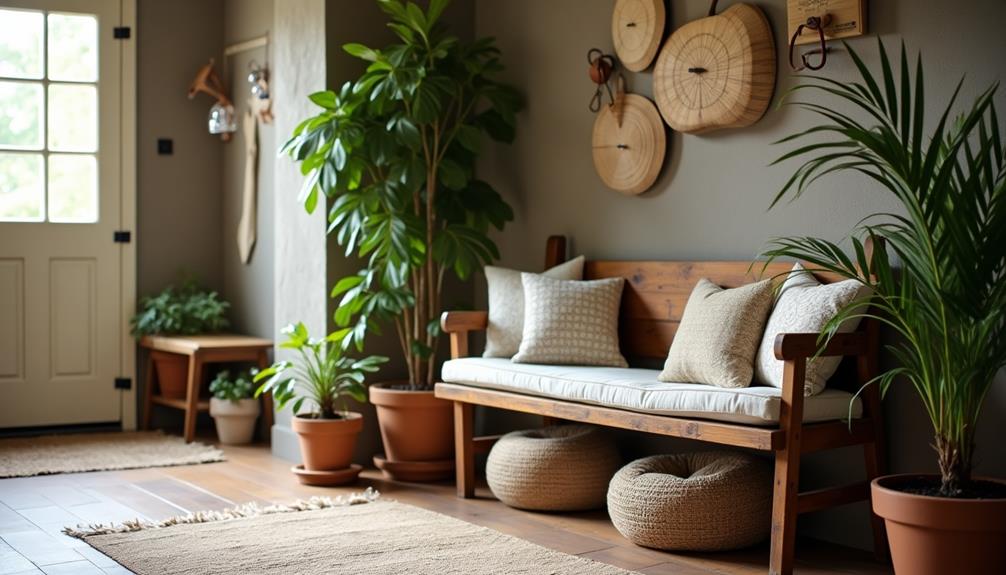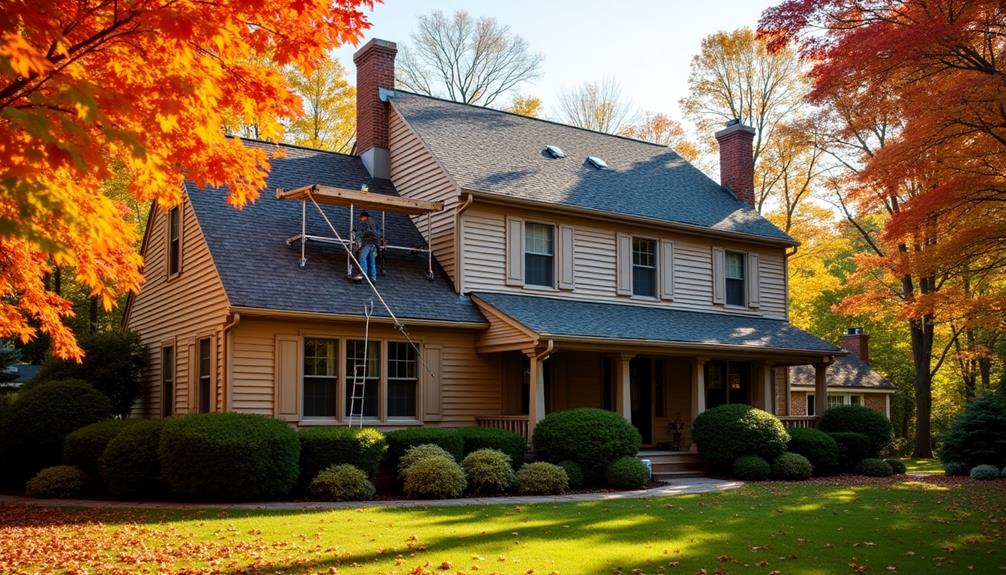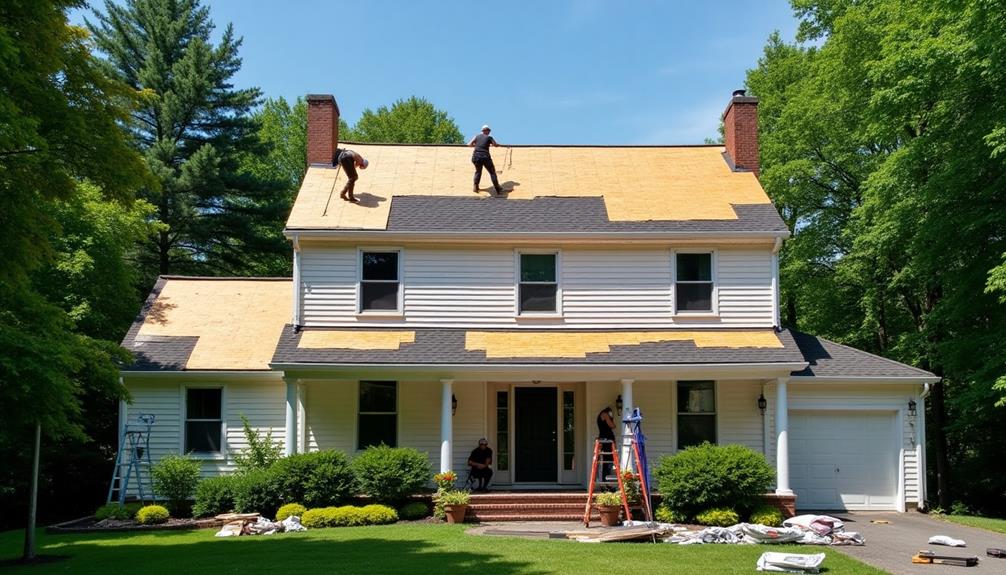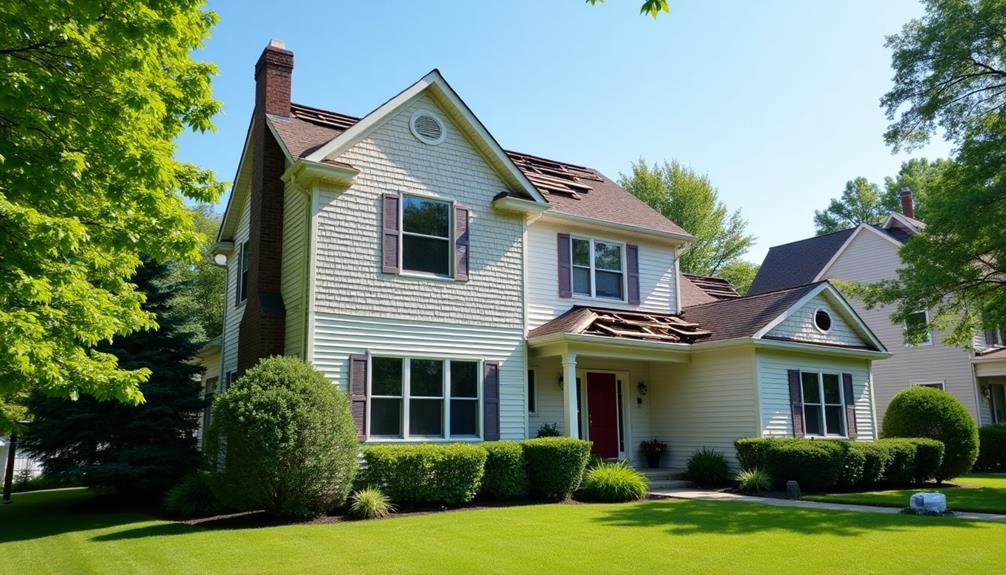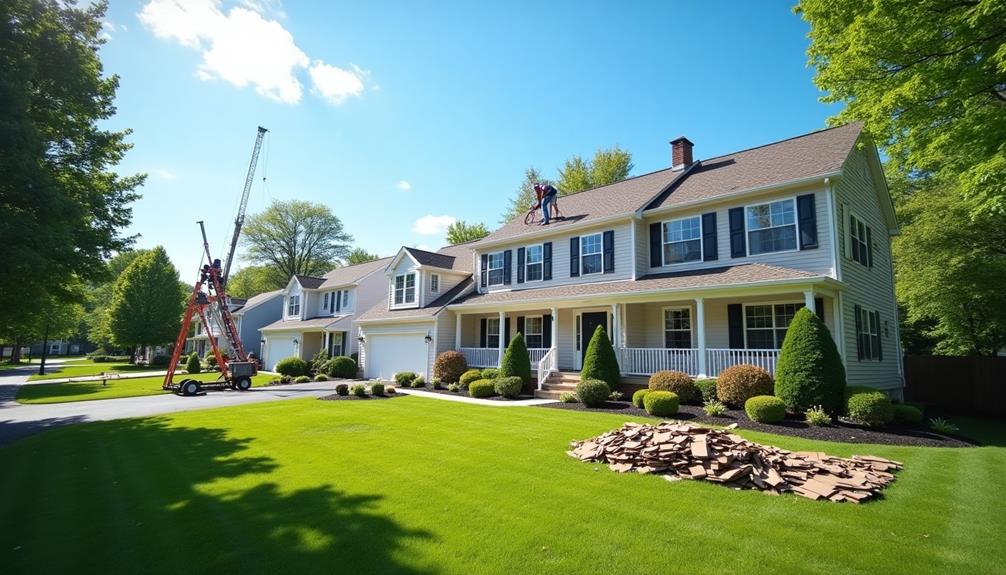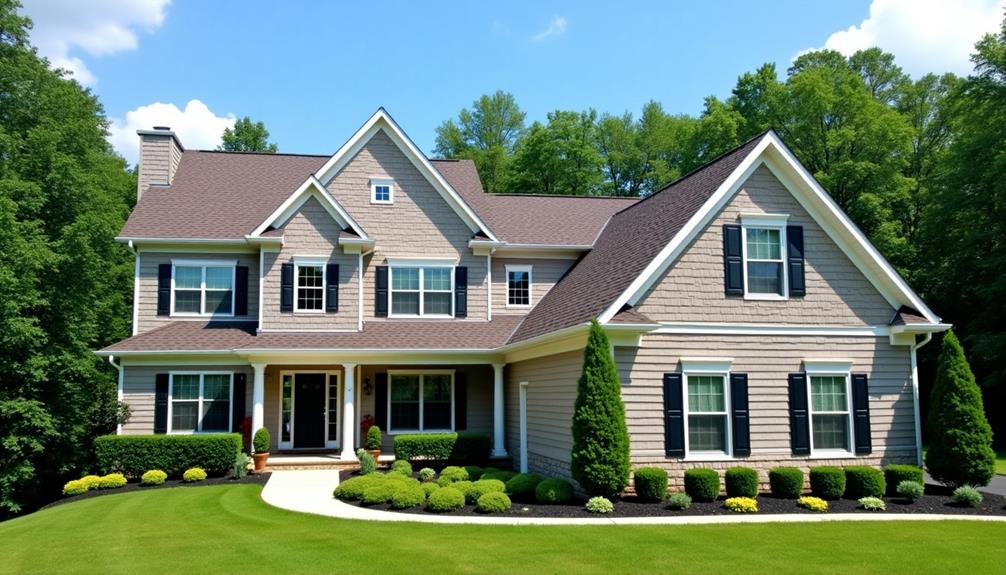Did you know that an entryway bench can increase your home's perceived value by up to 10%? It's not just about aesthetics; a well-designed bench can offer practical storage solutions and enhance the overall flow of your space. You might be wondering how to choose the right design and materials to match your style and needs. Understanding these elements can transform your entryway from a simple passage to a functional centerpiece that reflects your taste and meets your lifestyle demands.
Choosing the Right Design
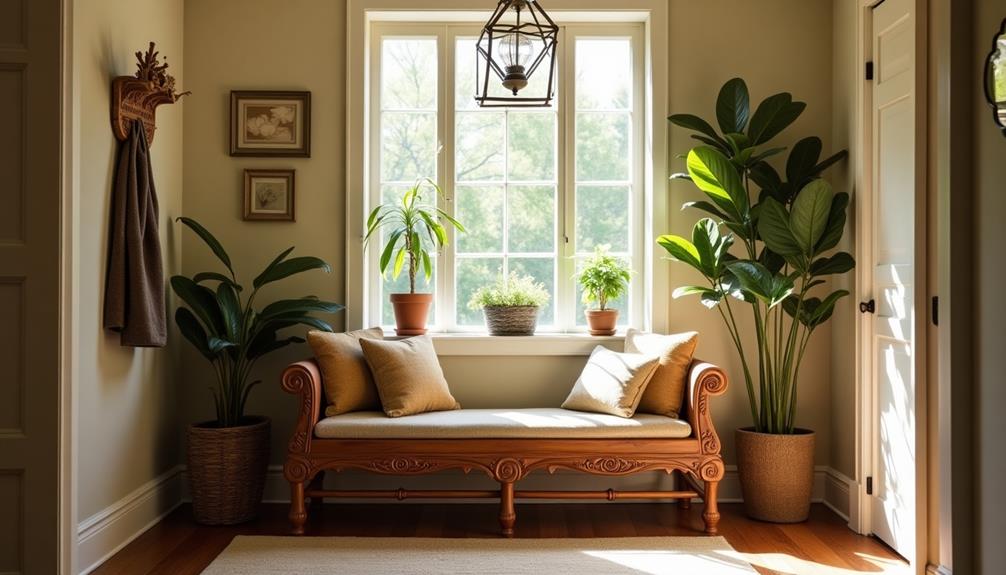
When selecting a design for your entryway bench, consider the overall style of your home. Your style preferences—whether modern, rustic, or traditional—will guide your choice, ensuring the bench complements your decor.
Think about functional considerations as well; a bench that doubles as storage can be incredibly useful in smaller spaces, especially if you face space constraints.
Pay attention to bench dimensions and seating capacity. You'll want to choose a size that fits comfortably within your entryway while providing enough seating for your family or guests. This balance of functionality and aesthetics is crucial.
Additionally, consider current design trends; a sleek, minimalist bench might align well with contemporary tastes, while a more ornate piece could suit a vintage aesthetic.
Color schemes play a significant role too. Choose colors that harmonize with your existing decor for maximum aesthetic appeal.
Whether you go for bold hues or subtle tones, the finish should enhance the overall look. By thoughtfully weighing these factors, you'll create an entryway bench that not only meets your practical needs but also elevates the style of your home.
Gathering Your Materials
Before you start building your entryway bench, you'll need to gather some essential tools and materials.
Think about what types of wood or other materials will best suit your design.
Having everything on hand will make the process much smoother and more enjoyable.
Essential Tools Required
To create a sturdy and stylish entryway bench, you'll need to gather a few essential tools that will make your project run smoothly. Start with a tape measure to ensure accurate dimensions. A circular saw will help you cut your wood pieces to size, while a drill is crucial for assembling the bench.
Don't forget a sander for smoothing out rough edges, which not only enhances the look but also contributes to tool safety by minimizing splinters. You'll also want a level to ensure your bench sits evenly, and clamps will keep everything secure while you're working.
Safety goggles and a dust mask are important for protecting yourself during the cutting and sanding processes.
Lastly, remember that tool maintenance is key to a successful project. Keep your tools clean and in good working order to avoid accidents and ensure longevity. Regularly check blades and bits for sharpness, and lubricate moving parts as needed.
With these tools in hand and a focus on safety and maintenance, you're set to tackle your entryway bench project with confidence!
Material Types Overview
With your tools ready, it's time to gather the materials for your entryway bench. First, consider your wood selection. Hardwoods like oak or maple offer excellent durability factors and a beautiful finish, while softer woods, like pine, are more budget-friendly but may not withstand heavy use as well.
Think about the cost considerations that fit your budget.
Next, decide on upholstery options if you plan to add cushions. Fabrics like canvas or faux leather are durable and easy to clean, while natural fibers can bring a touch of warmth but might require more upkeep.
Don't forget the finishing techniques! Stains and sealants can enhance your wood's appearance and protect it from wear and tear. Choose eco-friendly products where possible to minimize the environmental impact of your project.
Lastly, ensure all materials align with your design vision. By carefully selecting your materials, you'll create a beautiful bench that not only serves a functional purpose but also enhances the overall aesthetic of your entryway.
Now, let's move on to assembling your bench!
Essential Tools You'll Need
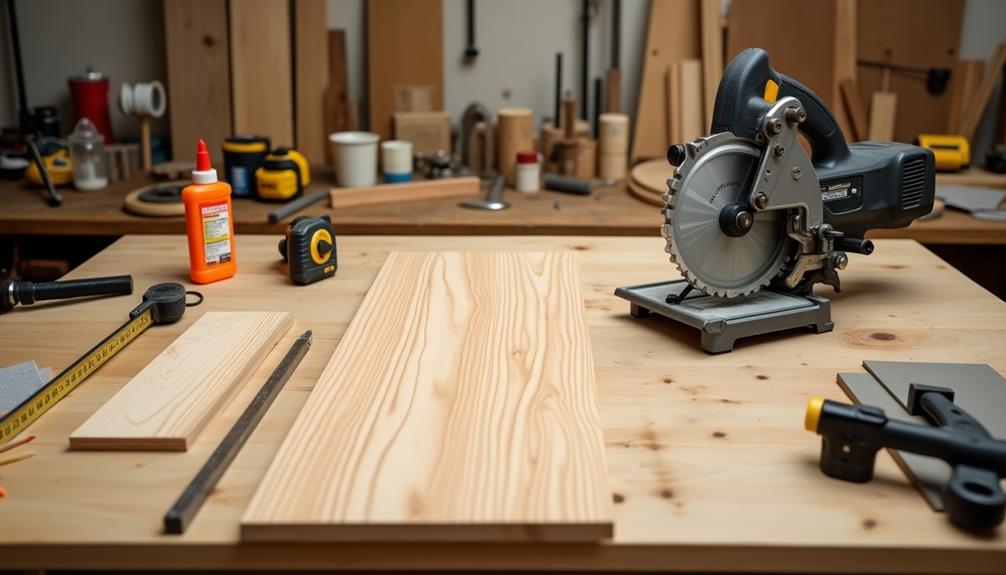
Getting started on your entryway bench project requires a few essential tools to ensure smooth sailing. First, you'll need a reliable measuring tape to ensure accurate dimensions; this is crucial for a well-fitted bench. A circular saw will be your go-to for cutting wood, while a drill is vital for assembling your pieces. Don't forget a level to guarantee your bench sits evenly.
For safety precautions, always wear protective eyewear and gloves while working with power tools. A dust mask is also a good idea to protect your lungs from wood particles. Additionally, it's wise to have a first aid kit nearby, just in case of minor accidents.
Tool maintenance is key to keeping your tools in top shape. Regularly clean your saw blades and drill bits to ensure clean cuts and efficient performance. Check for any damage before starting your project, and keep your workspace organized to prevent accidents.
Lastly, having a sturdy workbench or sawhorses will make your project easier and safer. With the right tools and a focus on safety, you'll be well on your way to creating a fantastic entryway bench!
Step-by-Step Construction Process
Now that you have your tools ready, it's time to gather the materials you'll need for your bench.
You'll want to follow clear assembly instructions to ensure everything fits together perfectly.
Let's get started on building a stylish and functional entryway piece!
Materials Needed
To build a sturdy and stylish entryway bench, you'll need a few essential materials that form the backbone of your project. Start with your wood selection—choose durable hardwoods like oak, maple, or birch for longevity and strength.
If you prefer a lighter option, consider softwoods such as pine or cedar, which are easy to work with and can be stained or painted to match your decor.
Next, gather the necessary hardware options. You'll need screws, brackets, and wood glue to ensure your bench is secure and stable. Consider using pocket hole screws for a cleaner look and added strength.
Don't forget about the finish; a good quality wood stain or sealer will protect your bench from wear and tear.
Additionally, if you want added comfort, think about upholstery materials for the top. A padded cushion can enhance the bench's functionality and style.
Lastly, don't forget tools like a saw, drill, and sander to help you shape and finish your project. With these materials on hand, you're ready to create a beautiful entryway bench that's both practical and inviting.
Assembly Instructions
Usually, assembling your entryway bench is straightforward and can be done in just a few hours.
Start by laying out all your materials and tools. Familiarize yourself with the joinery techniques you'll be using, such as pocket holes or dowel joints, to ensure a sturdy structure.
Begin with the bench frame. Attach the side pieces to the front and back using your chosen joinery technique. Make sure to pre-drill holes to prevent splitting the wood. Use wood glue along with screws for added strength.
Next, attach the seat to the frame. If you're using multiple boards for the seat, ensure they're flush and level. Consider adding a cleat underneath for extra support.
Don't forget to sand all surfaces smoothly to prevent splinters.
Once everything's assembled, apply your preferred finish, whether it's stain or paint, to protect the wood and enhance its appearance.
Finishing Touches and Decor
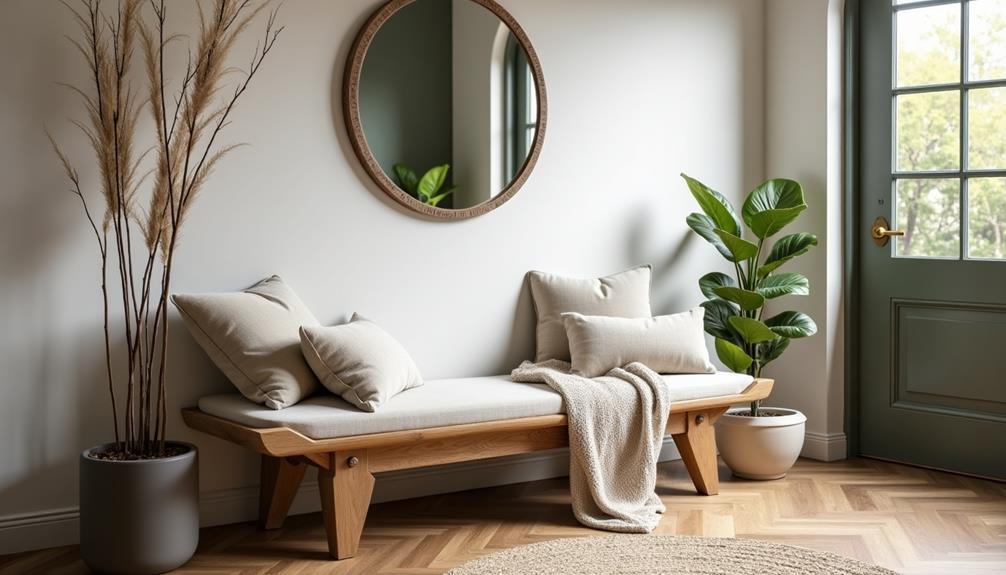
How can you elevate the look of your new entryway bench? Start by choosing a cohesive color scheme that complements your space. A well-chosen palette not only enhances aesthetic appeal but also creates a welcoming atmosphere.
Next, add decorative accents like throw pillows or a cozy blanket. These elements bring comfort and style, inviting guests to sit and stay awhile.
Incorporate functional storage solutions beneath your bench. Baskets or bins can keep shoes, bags, and other essentials organized while maintaining a tidy appearance.
To keep things fresh, consider seasonal decor—swap out items like cushions or wall art to reflect the changing seasons.
Don't forget to sprinkle in personal touches that showcase your personality. A framed photo or a unique sculpture can make your entryway feel truly yours.
Balancing aesthetics with a functionality focus ensures your bench isn't just beautiful but also practical. By thoughtfully combining these elements, you'll create a space that's both stylish and functional, making every entry and exit a pleasure.
Tips for Maintenance and Care
Maintaining your entryway bench is key to keeping it looking great for years to come. Start with regular cleaning techniques to remove dust and dirt. Use a soft cloth and a mild detergent, avoiding harsh chemicals that can damage the finish.
Seasonal checks are essential; inspect the bench for signs of wear or damage, especially after heavy use or seasonal changes.
Moisture control is critical, particularly if your bench is near an entryway exposed to the elements. Ensure proper ventilation to prevent mold and mildew growth. Applying protective coatings annually can significantly enhance the bench's durability, shielding it from scratches and stains.
If you notice any scratches or dents, don't stress. Use repair tips like wood filler for minor imperfections, and sand the area before repainting or refinishing to blend it seamlessly with the rest of the bench.

